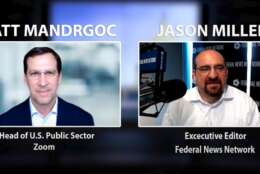SDFM The Business of Defense
-
This year marks the 75th Anniversary of the Administrative Procedure Act (APA). This “super statute” governs the way administrative agencies develop and issue regulations and allows for oversight of agency actions by federal courts. On FEDtalk this week, our guests take a brief look at the history of the APA and how the law has evolved over the last 75 years. Finally, the group discusses modern issues in administrative law and how these challenges impact the civil service.
August 06, 2021 -
“There's this massive influx of new applications that need to be deployed, new sets of data. Yet the IT admins aren’t really growing at the same kind of rate. So because of that, the idea is you need to start adopting more automation to really kind of bridge that gap,” said Garrett Clark, director Ansible GTM at Red Hat.
August 06, 2021 -
2020 was the first time in history the U.S. Census included an option to respond online. Wanting to find ways to encourage engagement, the U.S. Census Bureau created a public-facing map of responses by neighborhood…
August 05, 2021 Melinda Rogers, the chief information officer of the Justice Department, said a departmentwide effort to create a strategy and run zero trust pilots.
August 05, 2021-
Lashanda Hodge, the managing director of customer experience for GSA’s Center of Excellence, said helping agencies focus across five core areas will help break down siloes and bring data and people together.
August 04, 2021 -
This content is provided by Gordian. Infrastructure is in the spotlight once again as the Senate moves forward on its infrastructure bill. Part of that involves the modernization of existing federal buildings and construction of…
August 03, 2021 -
Experts from NASA, the Pacific Northwest National Lab and Zoom will explore how the culture change brought on by the pandemic will continue in the hybrid workforce.
August 02, 2021 -
Cybersecurity has become a data-driven activity. Predicting, responding to, mitigating and post-facto analysis of cybersecurity events all rely on having the applicable data available at the right time. Data itself originates in a variety of…
August 02, 2021 -
The Department of Defense is aimed at creating the smart base of the future. Bases are essentially miniature cities, with all the same infrastructure needs like transportation, on-base personnel services and energy management, coupled with specific military needs. The idea is to use a 5G infrastructure to connect all of these elements, as well as cybersecurity and physical security, to become fully integrated and agile.
August 02, 2021 -
Hosted by Dr. Richard Shurtz and Jim Russ. Sponsored by Stratford University. The best mouse we have ever used. And we tell you about the computer developer whose life story is a cautionary tale about protecting your intellectual property.
August 02, 2021 -
Matt Mandrgoc, the head of US public sector at Zoom, said the pandemic showed three things: Incumbent technologies were not necessarily scalable to satisfy the needs of the mass remote work environment; the culture change brought on by mass telework will be permanent; and cloud services were critical to all of these successes.
July 30, 2021 -
Experts from the Small Business Administration, Department of Homeland Security, General Services Administration and LexisNexis Risk Solutions will explore how agencies are approaching fraud prevention.
July 29, 2021 -
The Air Force and the Defense Department writ large are expecting 5G to be a game changer in the way it delivers information and connects platforms.
July 28, 2021 -
Dr. Robert Blumofe, the executive vice president and chief technology officer at Akamai Technologies, cited performance acceleration, Transport Layer Security (TLS) connection offloading, caching, and hosting the security stack itself, as candidates for edge computing.
July 27, 2021 -
Experts from the Cybersecurity and Infrastructure Security Agency, State Department, Defense Logistics Agency, Microsoft Federal and ServiceNow will explore how innovation and security can happen in tandem.
July 27, 2021














